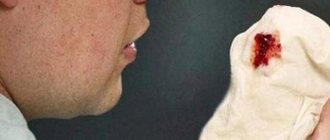Causes of hoarseness in adults
The causes of hoarseness lie in swollen, damaged vocal cords or in the presence of obstacles in the path of the sound wave. In this case, they talk about pathology of voice function or dysphonia. Hoarseness is a common symptom that most people experience from time to time. It usually goes away within a short time with home treatment.
If it persists for more than two weeks, it is recommended to consult a doctor.
What causes hoarseness:
- Laryngitis. The cause may be untreated acute laryngitis, which becomes chronic.
- Cysts and polyps on the vocal cords. Their asymmetrical arrangement interferes with the normal passage of the voice.
- Allergy. Seasonal or year-round, it often leads to hoarseness.
- Acid reflux. Laryngopharyngeal reflux is a fairly common cause of hoarseness. Hoarseness in this case often appears in the morning.
- Thyroid diseases. Low activity of the gland leads to hoarseness.
- Smoking. Active and passive smoking causes dysphonia.
- Exposure to irritants. Polluted air, inhaled chemicals, and burns lead to thickening of the ligaments and the appearance of scars on them, which impedes the passage of air.
- Long-term use of inhaled corticosteroids. Inhalers used for asthma or chronic obstructive pulmonary disease often affect the ligaments.
- Cancer of the larynx, lungs, thyroid gland, lymphomas. Often hoarseness is the first sign of the appearance of neoplasms, both benign and malignant.
- Injuries. Bruises and hematomas caused by an accident or during bronchoscopy or intubation lead to hoarseness.
- Spasmodic dysphonia. Periodic spasms of the laryngeal muscles prevent the passage of air.
- Vocal cord paralysis. Hoarseness occurs as a result of damage to the laryngeal nerves affected by surgery on the heart, head or neck.
- Influence of a foreign body. Swelling and inflammation may occur after the cause of suffocation is eliminated.
Not only an otolaryngologist should treat and restore a hoarse voice in an adult; a phoniatrist can also tell you how to do this.
Diagnostic measures
, smoking habits, alcohol consumption, and staying in a dry room are taken into account. A screening is carried out, during which the functions of the voice by ear are assessed, its gender and age correspondence, and stress tests are given. If at the same time the strength of the voice, its range, timbre changes, fatigue is noted after light loads, various disturbances in vocal breathing, fluency in speech, its clarity and intelligibility, a diagnosis of changes in the functioning of the vocal apparatus is made.
The patient also undergoes laryngoscopy, CT scan of the larynx, tracheoscopy, and, if necessary, consultation with a speech therapist and phoniatrist. The otolaryngologist will detect changes during laryngoscopy.
Groups of drugs used in the treatment of hoarseness
Treatment of hoarseness begins with eliminating the root cause of damage to the vocal cords. At the same time, medications are prescribed to relieve the symptom of hoarseness.
| Antiseptics | Miramistin, Corsotil, Falimint, Strepsils | Have an antiseptic and mild anesthetic effect |
| Corticosteroids | Prednisolone, Dexamethasone | Auxiliary products for the treatment of sore throat |
| Antibiotics | Penicillins, macrolides, fluoroquinols | Prescribed for chronic throat diseases, inflammatory processes in the larynx |
| Antibacterial | Grammicidin, Laripront | Have antimicrobial, antiviral effects |
| Antihistamines | Clarisens, Loratadine, Zyrtec | Reduce swelling of the mucous membrane |
In case of functional disorders, a phoniatrist carries out physiological correction and vocal training.
Etiotropic treatment
If hoarseness occurs due to infectious lesions, treatment is prescribed to eliminate the causes of the underlying disease.
- Expectorants that break down thick secretions from the throat, such as Mucinex, Robitussin.
- Proton pump inhibitors. Nexium, Protonix, prevent gastroesophageal reflux.
- Steroids. Decadron, Prednisolone reduce inflammation and associated swelling of the vocal cords, regardless of the cause of the inflammation.
- Antifungal drugs used in the treatment of candidal laryngitis, for example, Diflucan, Clotrimazole.
- Antibiotics. Used in the treatment of bacterial laryngitis.
- Drugs that reduce swelling of the mucous membrane , for example, Sudafed, Loratadine.
- Steroid nasal sprays: Flonaz, Nasonex.
- Amitriptyline, Nortriptyline, Ultram. Used in the treatment of dry cough secondary to sensory swelling of the larynx.
- Botulinum toxin. Used to treat spasmodic dysphonia.
In many cases, antihistamines of the 2nd and 3rd generations help relieve hoarseness: Clarisens, Loratadine, Zyrtec, Ebastine.
Physiology
Before determining the reason why the voice is hoarse and the cough appears, let's look at the mechanism of voice formation. When there are no problems with the vocal apparatus, we speak loudly and sonorously. How is this achieved? In fact, voice formation is not as simple a process as it might seem. It involves our lungs, trachea, nose, paranasal sinuses, mouth, teeth, tongue. But the most important role in voice formation is assigned to the larynx, or more precisely, its vocal cords.
The vocal cords are folds of muscle located in the center of the larynx.
The space between the vocal cords is called the glottis. Sounds are produced as you exhale. A stream of air emerges from the lungs and goes up to the larynx. During vocal production, the vocal folds close and the gap disappears. Under the influence of exhaled air, the ligaments begin to vibrate and sounds are formed.
The appearance of hoarseness is a consequence of the fact that the vocal cords are hoarse.
Swollen ligaments cannot fully close; accordingly, the glottis does not narrow, and sounds are reproduced distortedly.
In fact, there are quite a few reasons why hoarseness of the vocal cords appears, and infection is not always to blame.
Gargling and throat treatment
The causes of hoarseness can be eliminated with antiseptics and antihistamines. Also an effective remedy for hoarseness, in addition to ascorbic acid, are lozenges for the throat.
Local antiseptics:
- Iodinol. You can treat the throat 4-5 times a day, using 250 ml of solution at a time, gargling for at least 40 seconds.
- Lugol. Spray the spray in the area of the throat, pharynx and hold the air for 2-3 seconds. After the procedure, you should not eat or drink for ½ hour. Gargling with the solution or lubricating the throat is carried out 4-6 times a day.
- Yox. Combined preparation for ENT organs in the form of an aerosol or solution. Rinsing with jox diluted with water in a ratio of 1:20 is carried out 3-4 times a day.
- Saline solution. Physiological saline solution (9 g of salt per 1 liter of water) improves the pH environment of the larynx. Rinse 6-7 times during the day.
Gargling is one of the effective ways to treat a hoarse voice in an adult.
How to treat a hoarse voice in an adult using herbal antiseptics:
- Chlorophyllipt. Antiseptic, bactericidal solution contains a thick extract of eucalyptus and myrtle, infused with alcohol. To irrigate the throat, dilute 1 tsp. drug in 200 ml of warm water. The prepared mixture is used immediately, gargling for 3-4 minutes, 4 times a day.
- Salvin. An extract from sage leaves is used in the form of applications and throat irrigation. Before use, dilute with water.
Absorbents and tablets:
- Miramistin. Irrigation of the throat is carried out 3-4 times a day, 10-15 ml.
- Homeovox. For hoarseness, dissolve 1-2 tablets every 2 hours.
- Septolete, Laripront, Grammidin, Falimint.
Decoctions prepared from anise seeds, black radish juice, and herbal infusions effectively help treat a hoarse voice.
Recipes:
- Take ½ cup of anise seeds, add 500 ml of water and boil over low heat. Cool, strain, add 50 ml of alcohol and 2 tbsp to the added solution. honey. Drink a few sips every half hour throughout the day.
- Make a well in the middle of the peeled black radish and fill it with honey. Let it brew for several hours. The released juice should be drunk little by little throughout the day.
- Combine dried chamomile, calendula, plantain flowers in equal percentages, pour boiling water over them, and let steep for several hours. Rinse your throat every 2-3 hours.
Drinking a warm drink of herbal tea is effective in relieving hoarseness.
Inhalations
Inhalation sessions are prescribed for better penetration of drugs to the foci of inflammation in the larynx.
How to treat a hoarse voice in an adult using inhalations:
- the session is carried out 2 hours after eating;
- the duration of inhalation of drugs is no more than 10-15 minutes;
- vapors should be inhaled through the mouth and exhaled through the nose;
- after the session you must refrain from talking, eating, drinking for 30 minutes;
- No more than 3 procedures can be performed per day.
To carry out the procedure, you need to make a funnel from thick paper or cardboard. The wide part of it should accommodate the mouth and nose. Place the narrow part of the funnel in the teapot, and place the wide part to your mouth. Pour water into the kettle, no more than 30-40˚C, add a medicine or herbal solution.
Inhalations can be carried out over a wide bowl, adding hot water (30˚...40˚С) and a medicinal solution to it:
- Pour 10 g of chamomile flowers, 5 g of lavender flowers with water, bring to a boil, and simmer in a steam bath;
- soda solution: 1 tsp. soda for 1 tbsp. mineral water;
- decoction of dried apples;
- herbal teas.
A nebulizer, a device that produces finely dispersed medications, helps to quickly reach the source of inflammation.
Nebulizers can be:
- ultrasonic;
- compressor;
- mesh nebulizers.
Inhalation scheme:
- 1 hour before the session you should not eat or smoke;
- during inhalation, sit up straight and breathe evenly;
- after inhaling hormonal drugs, you should gargle;
- all inhalation preparations are prepared immediately before the session and cannot be stored in the refrigerator;
- After the session, you must thoroughly rinse all parts of the device.
Composition of solutions:
- calendula tincture + saline solution (1:20), 3 ml is enough for one session, carried out 3 times a day;
- propolis + saline solution (1:20), duration of sessions no more than 10 days;
- preparations containing the active ingredient ambroxol are diluted in a 1:1 ratio.
Dry inhalation, one of the simplest methods of treating hoarseness, is carried out by inhaling phytoncides secreted by plant or aromatic substances.
How to perform inhalation correctly:
- the session is carried out 1.5-2 hours after eating;
- You cannot talk or be distracted during the procedure;
- After the end of the session, you should rest for 10 minutes, do not talk, drink, or eat for 1 hour.
Recipes for dry inhalation:
- Aroma oils. Apply a few drops of eucalyptus or anise oil to a bandage folded several times. Inhale the vapor through your mouth and exhale through your nose.
- Onion and garlic. Rub the bandage, folded in several layers, with onion or garlic. Applying the bandage to your mouth, inhale the vapors for 5-10 minutes.
Warming with compresses and lotions
How to treat a hoarse voice in an adult using a warm compress:
- 1st layer – a piece of cloth, a bandage, folded 2-3 times, moistened with a medicinal or herbal remedy, applied to the throat;
- 2nd layer – film, oilcloth or waxed paper, extending 2-3 cm beyond the edge of the fabric;
- 3rd layer – cotton wool covering the entire structure.
Next, the throat is wrapped in warm woolen cloth. After 6-8 hours, the compress is replaced with a dry bandage or the skin is wiped with alcohol. At normal body temperature, you can apply a bandage soaked in alcohol to the throat. Doctor Mom or Travesil ointments applied to the bandage give a good warming effect.
In these cases, the compress must fit tightly to the throat, otherwise the evaporation from the drugs will cause a cooling effect rather than a warming one. The compress is contraindicated for diseases of the cardiovascular system, infections, during acute inflammatory processes, and at elevated temperatures.
Lotions are made for local cooling and constriction of blood vessels, to reduce pain. A bandage moistened with a solution of furatsilin (1:1000) or boric acid is applied to the throat. Every 2-3 min. The lotion is replaced with a new one, the procedure is carried out within an hour. Cold compresses should not be used at elevated temperatures.
Character of the cough
Cough is a very ambiguous symptom that may indicate the presence of a large number of different pathologies. You can draw any conclusions only by assessing the nature of the symptom.
Dry
A dry cough is a consequence of an irritant effect on the receptor apparatus. It is not accompanied by the release of any secretion, but patients often complain of pain.
A dry symptom is characteristic of many inflammatory diseases, blockage of the bronchial tube by a foreign object, and tumors. In this case, the voice, depending on the type of disease, may become hoarse, or may retain the same timbre.
Wet
The appearance of a wet cough and hoarse voice is a consequence of the accumulation of a specific inflammatory secretion, which irritates the receptor apparatus. Many diseases are characterized by the transition of a dry cough to a wet cough with sputum at the stage of resolution of the pathology.
When forming a wet symptom, the nature of the sputum plays a big role. Without sputum analysis, further diagnosis is most often not carried out.
Barking
A barking cough, which is a type of dry cough, is characteristic mainly of children. It develops due to swelling of the mucous membranes of the larynx area, but no pathological secretion is released. Often develops due to false croup or damage to the vocal cords. The throat may be red, which is typical for this type of symptomatology, as are complaints of a hoarse voice.
Coughing
Coughing is shortened, most often incomplete cough impulses. They most often occur in patients with tracheobronchitis and laryngitis. The symptom may appear in smokers, as well as in the initial stages of tuberculosis and with increased nervousness.
Homeopathy for hoarseness in adults
Alternative medicine can also tell you how to treat a hoarse voice in an adult. It is often used in complex therapy.
Popular drugs:
- Homeovox. Used for laryngitis and vocal cord fatigue.
- Aconite. Helps reduce swelling.
- Hamomilla. Activates voice restoration.
- Sanguinaria. An effective remedy for dysphonia.
- Mountain ram. Restores ligaments after overwork.
- Peppermint. Reduces hoarseness, restores voice.
- Pierced-leaved sapling. Helps with morning hoarseness.
- American hops. Relieves the sensation of a foreign body in the larynx, leading to hoarseness.
- Stillingia forest. Used for chronic hoarseness.
The choice of drug depends on the symptoms, the condition of the body, and the decision to take it should be made by a homeopathic doctor.
Diagnostics
If there are complaints of hoarse voice and cough, it is necessary to conduct a thorough diagnosis before starting any treatment. Making a diagnosis is especially important given the variety of causes for these symptoms.
Diagnosis begins with questioning and examining the patient. If a child comes to the appointment, then the parent should answer the doctor’s questions in as much detail and detail as possible. The first consultation will help to suggest the causes of a hoarse voice and cough, as well as select research methods to make an accurate diagnosis.
The following can be used as diagnostic measures:
- classical and biochemical blood tests;
- a swab from the throat, as well as culture of sputum, if any, for microflora;
- laryngoscopy – a study that helps assess the condition of the vocal cords;
- bronchoscopy is a study that helps assess the condition of the bronchial tree, but due to its invasiveness it is not used too often;
- radiography (if there is a suspicion of involvement of the lungs in the pathological process);
- Ultrasound diagnostics.
The choice of optimal methods depends on the characteristics of the symptoms. If the patient has a simple cold, then examination and basic tests are sufficient, but if there is a suspicion of a tumor, a more thorough diagnostic search will have to be carried out.
Folk remedies for throat infections
Recipes to help with sore throat:
- combine ½ glass of milk with ½ glass of Borjomi, heat to +25˚С, add 2 tsp. honey, drink the mixture for 30 minutes;
- yolk of 2 eggs combined with 1 tsp. sugar, add 1 tsp. butter and take the mixture little by little throughout the day;
- Mix water and aloe juice in a 1:1 ratio, gargle 3 times a day.
Best Natural Home Remedies:
- Ginger and sea salt. 2-3 tsp. mix ginger juice with ½ tsp. sea salt. Use the drinking mixture 1-2 times a day, after meals.
- Ginger and white radish. Grind and mix 50 g of fresh ginger, 50 g of radish. Before swallowing, keep the resulting mixture in your mouth for 5 minutes. Carry out the procedure 1-2 times a day after meals.
conclusions
Loss of voice is one of the unpleasant consequences of a cold or seasonal ARVI. Even if your general condition has improved dramatically, hoarseness or complete loss of voice may persist even after complete recovery. And you don’t know how to restore it, you need to seek help from an otolaryngologist. After a comprehensive diagnosis, the doctor will prescribe an effective treatment that will help restore your voice in 2 to 3 days.
To do this, it is important to stay at home and strictly follow the doctor’s recommendations. For complex therapy, medications and home remedies are used, such as drinking plenty of fluids, rinsing with decoctions of medicinal plants and inhaling with essential oils.
What not to do if your voice is hoarse
When treating and restoring the vocal cords, you must follow simple recommendations:
- Give up cigarettes. Tobacco smoke and passive smoking irritate the mucous membranes and aggravate the course of the disease.
- Avoid drinks containing caffeine. Cola and coffee dehydrate the body.
- Avoid spicy, hot, sour foods, alcohol. These products cause burns to the laryngeal mucosa and dehydration.
- External irritants such as smoke, cold air, dust, and aerosols should be avoided.
- Aspirin should not be taken as it reduces blood clotting. If the capillaries are damaged when the ligaments are damaged, the drug can cause bleeding.
- You should not allow overstrain of the vocal cords, try to speak in a quiet voice, or better yet remain silent.
How to treat a hoarse voice, this question should not arise for an adult if he is attentive to his health and does not neglect going to the doctor.
Author: Belyaeva Anna (bacheshca)
Possible complications
If an adult’s hoarse voice is not quickly cured using medication or traditional methods, this will lead to complications:
- voice defects in the future;
- suffocation, if the cause of hoarseness is swelling;
- degeneration of a non-dangerous disease into a more serious form;
- abscesses.
Moreover, the most dangerous complications can lead to death, so you should not neglect timely therapy to restore the ligaments and normalize the voice.










